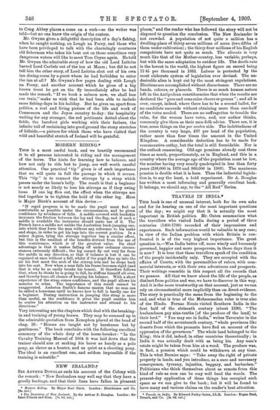MODERN RIDING.*
Tins is a most useful book, and we heartily recommend it to all persons interested in riding and the management of the horse. The hints for learning how to balance, and how not only to ride but to jump, are well worth careful attention. One practical " tip " given is of such importance that we will quote in full the passage in which it occurs. This "tip" is to connect the stirrups by a strap which passes under the horse's belly. The result is that a beginner is not nearly so likely to lose his stirrups as if they swing loose. If one leg flies out, the effect when the stirrups are tied together is to tighten the hold of the other leg. Here is Major Birch's account of this device :—
"If rapid progress is to be made the pupil must feel as comfortable as possible under the circumstances, and be given confidence by avoidance of falls. A saddle covered with buckskin increases the friction between the leg and the flap, and if such a saddle is available the instructor should make use of it. The French have a saddle not unlike the Australian buck-jumping one, into which they force the man without any reference to his make and shape, in order to get his legs into the correct position. In a minor degree, tying the stirrups together has a similar effect, but this is the smallest of the benefits derived from the use of this contrivance, which is of the greatest value. Its chief advantage is that it makes falling off under ordinary circum- stances extremely difficult ; the leg cannot fly out very far from the saddle in any direction, so that if balance is lost it can be regained at once without a fall, whilst if the pupil flies up into the air his feet meet the arch of the stirrup iron and he drops back into his seat. Now when a man falls his frame becomes rigid (and that is why he so easily breaks his bones). It therefore follows that, when he thinks he is going to fall, he stiffens himself all over, and thereby loses all chance of keeping his balance. With a short experience of the strap comes confidence, and the pupil allows his muscles to relax. The importance of this result cannot be exaggerated. Assheton Smith's famous maxim that no man can be called a horseman until he knows how to fall is hardly one for a beginner. During instruction in jumping this strap is more than useful, as the confidence it gives the pupil enables him to centre his attention on the instructor and attend to his directions."
Very interesting are the chapters which deal with the breaking. in and training of young horses. They may be summed up in the admirable quotation from Xenophon placed at the head of chap. 20: "Horses are taught not by harshness but by gentleness." The book conclude e with the following excellent summary of the whole duty of the horse-breaker : "In the Cavalry Training Manual of 1904 it was laid down that the trainer should aim at making his horse as bandy as a polo pony, as clever as a hunter, and as quiet as a shooting pony. The ideal is an excellent one, and seldom impossible if the training is scientific."






































 Previous page
Previous page